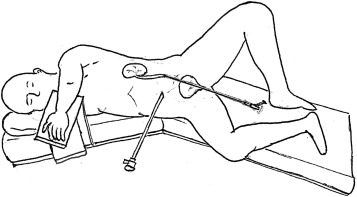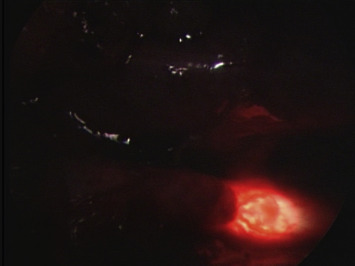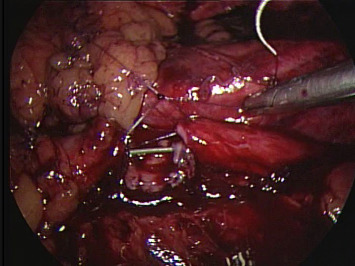Summary
In a case of upper ureteral stricture refractory to laser ureterotomy, laparoscopic ureteroureterostomy was performed for resection of the stricture and reanastomosis of the ureter. Precise localization of the stricture segment was achieved by retrograde ureteroscopy performed concurrently with laparoscopy, with minimal change in the patients position.
Keywords
laparoscopy;ureteral stricture;ureter;ureteroscopy;ureteroureterostomy
1. Introduction
Among the different types of treatment for benign ureteral stricture, ureteroureterostomy provides the opportunity of complete resection of the affected part, and reconnection of the healthy ureter. It is favored by capable surgeons after the introduction of minimally invasive surgery, which involves smaller wounds. In most cases, the level and extent of obstruction can be evaluated through imaging and determined under direct vision. In rare cases, however, the site of stricture cannot be identified from the extraluminal aspect under laparoscopy. This poses serious difficulty for surgeons; probably leading to conversion to open surgery, which does not guarantee a satisfactory outcome. We present such a case, and a novel method to localize a lesion.
2. Case report
A 48-year-old woman presented at our clinic with persistent left flank pain after ureteroscopic lithotripsy. Some polyps were noted in the procedure, and the result of biopsy was fibroepithelial polyp. Laser ureterotomy was performed 3 months after the ureterolithotripsy, and a double J stent was inserted; however, flank pain recurred after removal of the stent. Follow-up renal echography showed hydronephrosis. Renal scan showed preserved function of the left kidney, thus the patient underwent laparoscopic ureteroureterostomy.
3. Technique for localization
The patient was set in a semi-flank position. A 5–12-mm trocar was set at the paraumbilicus for laparoscope, and two 5-mm trocars were placed in the left lower abdomen as working ports. The retroperitoneum was dissected to display the left ureter. Careful inspection could not find an obvious scar tissue or adhesion along the ureter.
In order to perform retrograde ureteroscopy, the operative field and instruments were covered with sterile sheets, leaving only the laparoscope still targeting the ureter. The patients left leg was then retracted upward with the trunk still in semiflank position (Fig. 1). A semirigid ureteroscope was inserted and preceded to the site of stricture, while the light source of the laparoscope was dimmed. The tip of the ureteroscope could be seen under the dimmed laparoscope. Abnormal ureteral mucosa could also be identified under ureteroscopy. The ureteroscope was then proceeded further until the end of the stricture, thus both ends of the stricture site were confirmed (Fig. 2).
|
|
|
Figure 1. Position for concurrent laparoscopy and retrograde ureteroscopy. |
|
|
|
Figure 2. Light from the ureteroscope could be seen through the ureter under laparoscopy. |
Only a guidewire was left in the ureter after the ureteroscope was retracted. The patients leg was pulled back to the normal position. The stricture part was resected under laparoscopy, and the reanastomosis was performed with a running suture (Fig. 3).
|
|
|
Figure 3. Reanastomosis was performed with a running suture. |
Cystoscopy was performed again to insert a double J stent into the ureter after reanastomosis was completed, and the postoperative plain X-ray (KUB) showed proper position of the double J stent. The stent was removed 1 month later. Follow-up renal echography showed mild hydronephrosis, and the patient experienced no discomfort afterwards.
4. Discussion
Laparoscopic ureteroureterostomy has been reported in the treatment of retrocaval ureter, iatrogenic injury during gynecological surgery, and benign strictures.1; 2 ; 3 In most situations, special attention is not required for localization of the lesion. In some cases of benign stricture, however, one may encounter difficulty or uncertainty in identifying the site of the lesion or determining the length of resection. Failure to recognize the exact part of stricture may result in incomplete resection as well as a shortened ureter, leaving obstacles for future reconstruction. In performing minimally invasive surgery, including robotic assisted surgery, lack of tactile feedback further precludes the precise localization of the lesion.
Our new technique using intraoperative ureteroscopy is feasible with minimal change in the patients positioning, and it enables us to determine the site of ureteral stricture from internal and external aspects.
References
- 1 T. Matsuda, R. Yasumoto, T. Tsujino; Laparoscopic treatment of a retrocaval ureter; Eur Urol, 29 (1996), pp. 115–118
- 2 P.K. Tulikangas, I.S. Gill, T. Falcone; Laparoscopic repair of ureteral injuries; J Am Assoc Gynecol Laparosc, 8 (2001), pp. 259–262
- 3 D.S. Bhandarkar, J.G. Lalmalani, V.J. Shah; Laparoscopic resection and ureteroureterostomy for congenital midureteral stricture; J Endourol, 19 (2005), pp. 140–142
Document information
Published on 26/05/17
Submitted on 26/05/17
Licence: Other
Share this document
Keywords
claim authorship
Are you one of the authors of this document?


